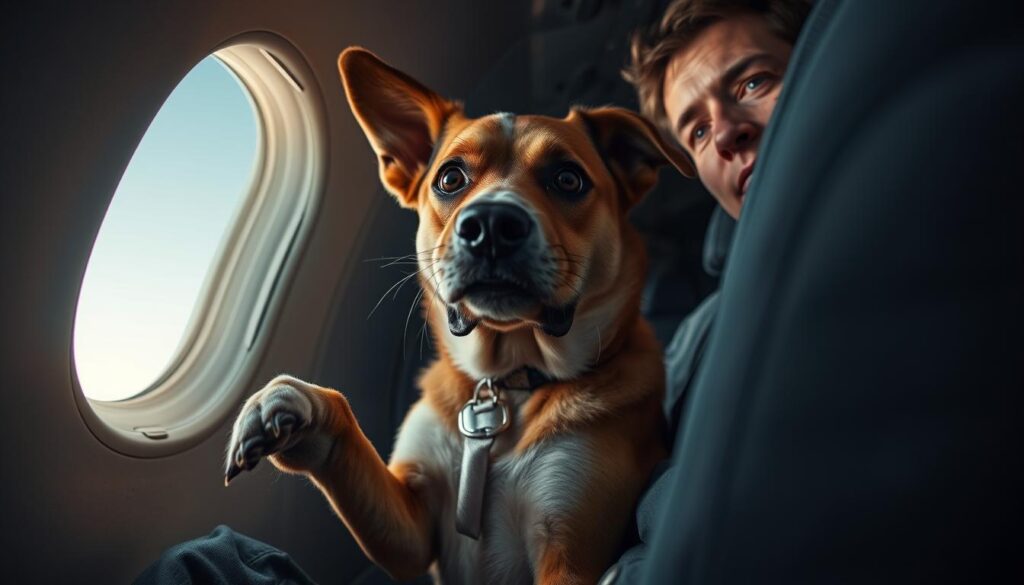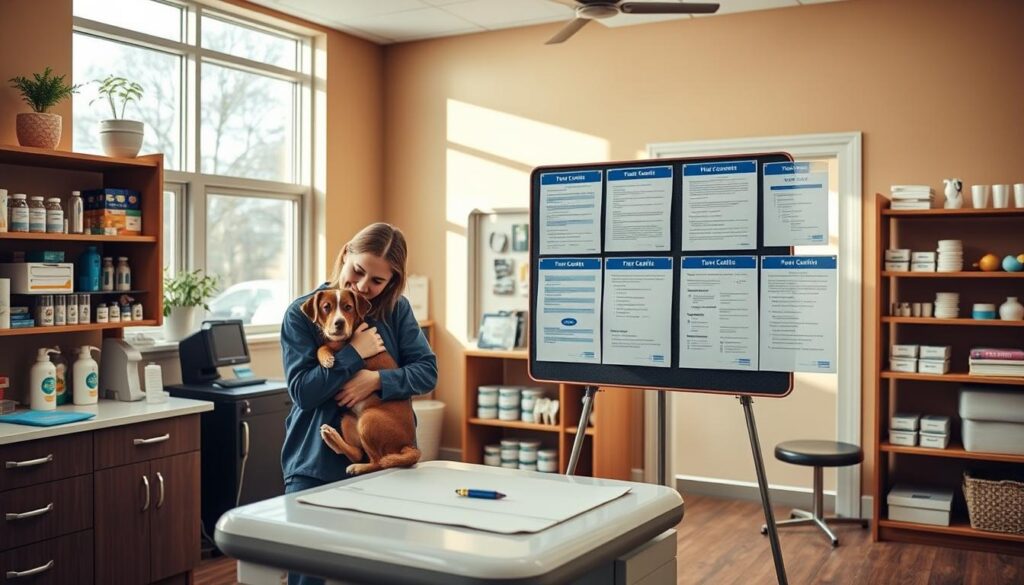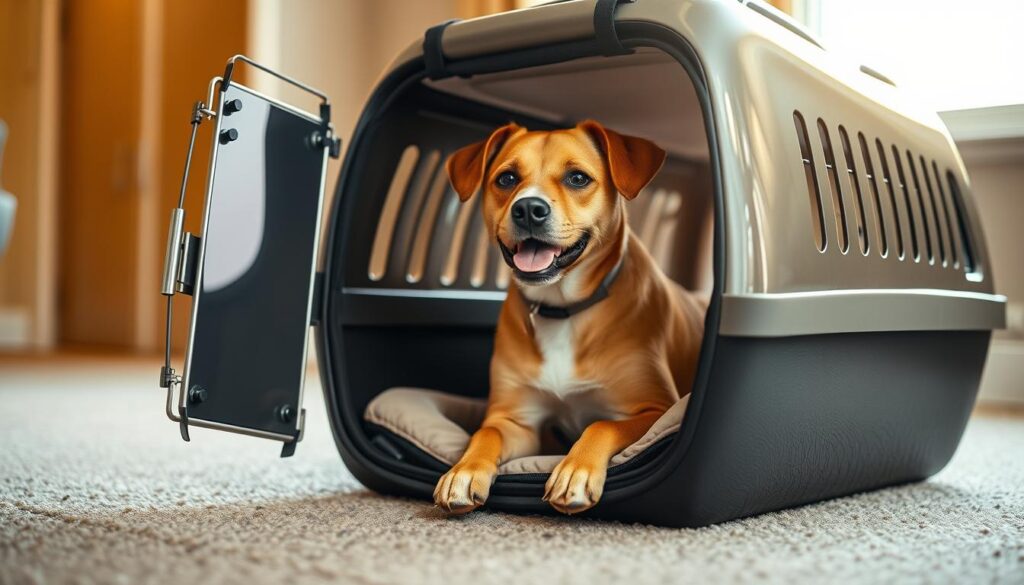Traveling with your furry friend can be challenging, but flying is even more daunting. To keep your dog safe during air travel, you need to plan carefully.
To ensure your dog’s flight is safe and comfy, you must know the steps for pet travel. We’ll cover everything from pre-flight prep to post-flight care.
Our expert tips will help you avoid risks and make the trip smooth for both you and your dog.
Key Takeaways
- Understand pre-flight preparations for your dog
- Learn about in-flight safety measures for pets
- Discover post-flight care tips for your dog’s comfort
- Explore expert advice for minimizing travel risks
- Find out how to ensure a smooth journey for you and your dog
Understanding the Challenges of Flying with Dogs
Flying with dogs can be tough. It’s important to make sure they’re safe and comfortable. Dogs get stressed from the new sights, sounds, and feeling trapped.
Physical and Emotional Stress on Dogs During Air Travel
Dogs face physical stress from the flight’s pressure changes and tight spaces. They also get emotional stress from the noise and shaking. This can lead to dog anxiety during flights.
Common Risks and How to Mitigate Them
There are risks like dogs trying to escape, getting sick, and acting stressed. To avoid these, pick a airline-approved carrier and follow airline pet policies.
| Risk | Mitigation Strategy |
|---|---|
| Escape Attempts | Use a secure, airline-approved carrier |
| Health Issues | Obtain a health certificate before flying |
| Stress-Related Behaviors | Acclimate your dog to the carrier before travel |

Benefits of Proper Preparation
Getting ready properly can lower the risks of flying with dogs. Knowing airline pet policies and taking steps to avoid common problems can make the trip safer and more comfortable for your dog.
Pre-Flight Veterinary Considerations
Getting a pre-flight vet visit is key to keep your dog safe and healthy in the air. It’s not just a formality. It’s a vital step to prepare your dog for flying’s stresses.
Required Health Certificates and Vaccinations
Getting the right health certificates for dogs is crucial. These certificates show your dog is fit for travel and has the needed shots. The shots needed can change based on where you’re going. So, talk to your vet early to make sure you have everything.
Pre-Flight Health Check Recommendations
A detailed health check before flying can spot health problems that flying might make worse. Your vet can check if your dog is ready for flight. They can also give tips on how to reduce risks of pet travel.
Discussing Sedation Options with Your Vet
Talking about sedation for flying with dogs is important. Sedation might seem like a calm solution, but it’s not always the best choice. It’s vital to discuss it with your vet.
When Sedation May Be Appropriate
Sometimes, sedation is suggested for very anxious or stressed dogs. But, it should only be used with your vet’s careful guidance. This is because of risks like breathing problems at high altitudes.
Natural Alternatives to Consider
For many dogs, natural ways to calm down are better than sedation. Options include calming treats, pheromone diffusers, and calming music. These can help soothe anxious pets.

By thinking about these vet factors before flying, you can make your dog’s journey safer and less stressful.
Choosing the Right Carrier for Your Dog
Finding the perfect carrier for your dog is key to their comfort and safety in the air. It’s more than just a way to transport them; it’s their personal space. The quality of the carrier greatly affects their flight experience.
Airline-Approved Carrier Requirements
Before picking a carrier, check with your airline for their airline-approved dog carriers rules. Each airline has its own set of dimensions, materials, and ventilation standards for carriers.
- Check the airline’s website or contact their customer service to understand their pet travel policies.
- Ensure the carrier is made of approved materials and has adequate ventilation.
Size and Comfort Considerations
The carrier’s size is crucial for your dog’s comfort. It should be big enough for your dog to stand up, turn around, and lie down comfortably. Think about the dog carrier comfort when picking the size.

Features to Look for in a Quality Dog Carrier
A quality dog carrier should have certain features to improve your dog’s travel experience. These include:
Ventilation and Security Features
Good ventilation is key so your dog can breathe easily. Security features, like secure latches, are also important to prevent the carrier from opening by accident during the flight.
Comfort Accessories Worth Adding
To make your dog more comfortable, consider adding soft bedding or familiar toys. These can offer emotional comfort during the flight.
| Feature | Importance | Recommendation |
|---|---|---|
| Ventilation | High | Mesh panels |
| Security | High | Secure latches |
| Comfort | Medium | Soft bedding |
By choosing a carrier that meets airline standards and focuses on your dog’s comfort, you can lessen the stress of flying with your pet.
Preparing Your Dog for the Flight Experience
Getting your dog ready for a flight is all about preparation. This includes getting them used to their carrier and packing comfort items. Making sure your dog is comfy and safe in their carrier helps reduce stress for both of you during the flight.
Carrier Acclimation Training Techniques
Getting your dog used to their carrier is key. Start by putting treats and toys inside to make them want to go in. Slowly increase the time they spend in it, making it a cozy and safe spot. Consistency and positive reinforcement are key to successful carrier acclimation.

Exercise and Bathroom Routines Before Departure
Make sure your dog is tired and has gone to the bathroom before you leave for the airport. A tired dog is happier and less stressed during the flight. Take them for a walk or playtime before heading out, and let them use the bathroom right before they go in the carrier.
Packing Essential Comfort Items
Choosing the right items can greatly improve your dog’s comfort during the flight. Include familiar toys and blankets that offer comfort and reassurance.
Familiar Toys and Blankets
Familiar items, like toys and blankets, carry the scent of home. They can be a big comfort in a new place. Pick a few favorite toys and a blanket your dog loves, and put them in the carrier.
Calming Aids and Their Proper Use
Calming aids can help anxious dogs. These include pheromone diffusers and calming treats. Talk to your vet to find the best calming aids for your dog and learn how to use them right. Always follow the recommended dosage instructions to keep your dog safe.
A famous animal behaviorist says, “Calming aids, used correctly, can greatly lower a dog’s stress during travel. This makes the trip better for both the dog and the owner.”
“Calm dogs travel better, and with the right preparation, you can ensure a smooth journey for your furry friend.”
Can Dogs Eat During Flights Safely?
As you prepare for your flight with your dog, you might wonder if they can eat during the trip. It’s important to think about their nutrition during air travel.
Timing of Pre-Flight Meals
Give your dog a light meal a few hours before flying. This helps avoid discomfort during the flight. Don’t feed a big meal right before flying to prevent motion sickness.
Food and Water Restrictions During Air Travel
Airlines have rules about food and water for dogs on flights. It’s best to limit what they eat and drink to avoid accidents and discomfort.
Safe Snack Options for In-Flight Consumption
Choosing the right snacks for your dog is key. Go for easy-to-digest, non-perishable snacks like carrots or dehydrated dog treats.
Hydration Considerations
Keeping your dog hydrated is crucial. You can give them ice cubes or a bit of water during the flight. But, always check with the airline first.
Foods to Absolutely Avoid
Some foods are bad for dogs, even more so during flights. Stay away from fatty foods, chocolate, and anything that could upset their stomach.

| Snack Type | Safety | Notes |
|---|---|---|
| Carrots | Safe | Easily digestible |
| Dehydrated Treats | Safe | Non-perishable |
| Fatty Foods | Not Safe | Can cause stomach upset |
| Chocolate | Not Safe | Toxic to dogs |
By choosing safe, healthy snacks for your dog during the flight, you can make sure they have a comfortable and safe trip.
Cabin vs. Cargo: Making the Safest Choice
When you fly with your dog, choosing between cabin or cargo is key. This choice affects your dog’s safety and comfort during the flight.
Size Restrictions for Cabin Travel
Airlines set size limits for dogs in the cabin. Your dog’s carrier must fit under the seat in front of you. It should also allow your dog to stand up and turn around easily. Always check with your airline for their exact rules.
Understanding the Risks of Cargo Hold Travel
Dogs in the cargo hold face stress from noise, pressure changes, and temperature swings. Even with precautions, there’s a risk of injury or health problems.
Airlines with the Best Safety Records for Pet Transport
Some airlines are better at handling pets. Alaska Airlines and JetBlue are known for their pet-friendly cabin policies.
Temperature-Controlled Cargo Options
Some airlines have cargo areas that keep a steady temperature. This can help reduce risks from extreme temperatures.
Special Pet-Friendly Flight Services
Some airlines offer special pet services. They include direct flights and extra care for pets during the flight.
| Airline | Cabin Pet Policy | Cargo Pet Policy |
|---|---|---|
| Alaska Airlines | Allows dogs up to 20 lbs in cabin | Temperature-controlled cargo hold |
| JetBlue | Pets allowed in cabin, carrier fits under seat | Not available for all flights |
Airline Policies Comparison for Dog Travel
Planning to fly with your dog? It’s key to know the different airline policies. Each airline has its own rules and restrictions for pets.
Major US Carriers’ Pet Policies
Airlines like American Airlines, Delta, and United have their own pet travel rules. For example, American Airlines lets dogs in the cabin on most flights. They must fit in a carrier and meet size requirements.
Budget Airlines vs. Premium Carriers
Budget airlines, like Spirit Airlines, have tighter pet policies and extra fees. On the other hand, premium carriers might offer more perks and flexibility for pet travel.
Additional Fees and Reservation Requirements
Most airlines charge a fee for pet travel, which can be $100 to $250 each way. You’ll also need to book in advance.
Seasonal Restrictions to Be Aware Of
Some airlines limit pet travel during extreme weather. It’s good to check these restrictions.
| Airline | In-Cabin Pet Policy | Fee |
|---|---|---|
| American Airlines | Allowed in cabin on most flights | $125 |
| Delta Air Lines | Allowed in cabin with size restrictions | $95-$125 |
| United Airlines | Allowed in cabin with specific carrier requirements | $125 |
Managing Your Dog’s Anxiety During Flights
Flying can be scary for dogs. It’s important to help them feel safe and comfortable. Dog owners can take steps to ease their pet’s stress in the air.
Natural Calming Methods and Products
There are natural ways to calm your dog during flights. Pheromone diffusers, calming treats, and dog-friendly music can help. Products with L-theanine or chamomile work well too.
Recognizing Signs of Distress
Watch for signs of anxiety in your dog, like panting or pacing. Catching these early helps you use calming strategies.
Techniques for Comforting Your Dog When Possible
On the flight, calm your dog with soft words and treats. If they’re in cargo, make sure their carrier is comfy and well-ventilated.
What to Do During Layovers
At layovers, let your dog stretch and go to the bathroom if you can. Use familiar comforts like toys or blankets to keep them calm.
Emergency Situations and How to Handle Them
In emergencies, stay calm and follow the crew’s instructions. Having a plan and being ready can help a lot.
Understanding and addressing your dog’s anxiety can make flying less stressful for them. Talk to a vet for advice on managing flight anxiety.
Post-Flight Care for Your Dog
The journey doesn’t end when the flight does. It’s just as important to care for your dog after travel as before. After arriving, give your dog the care they need to recover from flying stresses.
Signs of Travel Stress to Watch For
Watch for signs of travel stress in your dog. Look for excessive panting, pacing, or whining. These can mean your dog is uncomfortable or anxious.
Reestablishing Routines After Travel
Help your dog settle back into their routine. This can make them feel comfortable and normal. Try to reestablish regular feeding times, exercise, and sleep schedules as soon as you can.
When to Seek Veterinary Attention
If your dog shows severe signs of distress, seek vet help. A vet can offer guidance and treatment if needed.
Helping Your Dog Readjust to New Environments
When traveling, dogs may need help adjusting to new places.
“A familiar item, like a favorite toy or blanket, can provide comfort in a new setting.”
Conclusion: Ensuring a Safe and Comfortable Journey for Your Canine Companion
Planning a safe and comfy trip for your dog is key. Follow the tips in this article to reduce flying risks and make your dog’s journey enjoyable.
Every step, from before to after the flight, matters for your dog’s safety and comfort. Airlines like Delta and American Airlines have rules for pets. Knowing these can help you plan better.
Choosing the right carrier and preparing your dog for the flight are crucial. Also, understanding airline policies can make your dog’s travel better. This way, you ensure a safe and comfortable trip for your furry friend.






